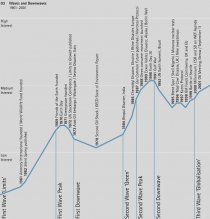Historical Environmental Issues
In order for us to fully understand the Planet imperative of sustainability, it can be helpful to consider a historical context for the environmental issues that have shaped our world. Elkington has delineated the events of the last generation into three environmental "pressure waves" of public opinion occurring from 1961-2001:

Corporate Sustainability Report and Sustainable Development frameworks (frequency of mentions, 1961–2001).
Three pressure waves
From 1960 to the present, three great waves of public pressure have shaped the environmental agenda. The roles and responsibilities of governments and the public sector have mutated in response to each of these three waves – and will continue to do so. Although each wave of activism has been followed by a downwave of falling public concern, each successive wave has significantly expanded the agendas of politics and business:
- Wave 1 brought an understanding that environmental impacts and natural resource demands have to be limited, resulting in an initial outpouring of environmental legislation. The business response was defensive, focusing on compliance, at best.
- Wave 2 brought a wider realization that new kinds of production technologies and new kinds of products are needed, culminating in the insight that development processes have to become sustainable – and a sense that business would often have to take the lead. The business response began to be more competitive.
- Wave 3 focuses on the growing recognition that sustainable development will require profound changes in the governance of corporations and in the whole process of globalization, putting a renewed focus on government and on civil society. Now, in addition to the compliance and competitive dimensions, the business response will need to focus on market creation.
(Elkington, 2004)
While he has not updated this annotated graph, it is important to note that Elkington has since referred to a "Sustainability Wave" which began in 2005, and which reached its relative peak around 2012. Let's hope that peak continues to rise!
One pressure wave event not specifically noted in the graph, but which has had tremendous influence, is the creation of the Environmental Protection Agency (EPA) in 1970. While we will more closely examine the influence of the EPA and regulatory pressures later in this lesson and in future lessons, it is worth noting that in the American environmental movement, the influence of the EPA is not to be underestimated.
In the case of innovation, the regulatory realm presents a significant set of opportunities which can be leveraged to create sustainability-oriented products and services. We must always consider that with any set of constraints and limitations introduced into an organization, whether externally introduced (i.e., regulatory, competitive) or internally introduced (i.e., self-imposed), there is an opportunity for a product or service to bridge the void. We will dive more deeply into how exactly to accomplish this in later lessons, but it is important that we view every sustainability challenge as an opportunity.
The innovation implications of a single event
In keeping with the idea that 'every sustainability challenge is an opportunity, ' examine the pressure wave events Elkington notes and consider the implications of each event. Regardless of our views on any specific outcome, consider the depth of implications from even one of the environmental events.
Check Your Understanding
Consider some of the cascading implications of the 1973 Arab Oil Embargo (which was noted as part of the "First Downwave" by Elkington):
- CAFE (Corporate Average Fuel Economy) standards are enacted in 1975 to increase the fuel efficiency of passenger cars and light trucks.
- The new concern with fuel economy in the American public moves increased attention to smaller, more fuel efficient Japanese and European autos.
- Auto manufacturers begin to move away from engineering platforms which have been the norm for decades before: heavy body-on-frame vehicles, with thirsty V8s.
- New technologies are needed to meet the CAFE regulations.
What specific innovations can you think of that were the results of these cascading implications?
If you would like, jot a few notes below... and then click the link to reveal sample areas of interest.
Click for areas of potential interest.
Innovations:
- An entire wave of new engineering and supplier development begins to take hold.
- Ever heard of a thing called a BMW or a Toyota? Thank the Embargo.
- Technologies which had been viewed as curiosities for decades before are reexamined; diesel autos gain significant popularity in the US.
- Turbocharging, fuel injection, overdrive transmissions, electric fans and a plethora of other developments are applied to vehicles.
Why do I mention these implications? Because in every case, growth and innovation was the response. We must always remember that regardless of the reason, any time an organization or industry is in a state of flux, it is an opportunity for the innovator or the upstart to gain a foothold. In the case of the 1973 Arab Oil Embargo, it was a groundswell of automotive innovation and a resurgence of development into technologies which may have been cost-prohibitive curiosities in the past.




